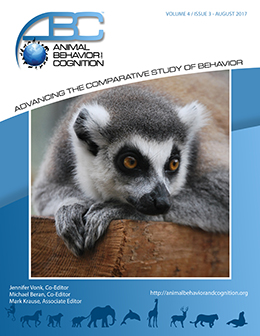Vol 4, Issue 3, August 2017
Fish are Sensitive to Expansion-Contraction Color Effects
Citation
Albertazzi, L., Rosa-Salva, O., Da Pos, O., Sovrano, V. A. (2015). Fish are sensitive to expansion-contraction color effects. Animal Behavior and Cognition, 4(3), 349-364. https://doi.org/10.26451/abc.04.03.12.2017
Abstract
Some visual phenomena reveal the visual system’s tendency to structure the scene according to rules that do not always have a direct correspondence in the external physical world. Color information can affect the perception of other object attributes such as size, generating contextual expansion, and contraction effects. We investigated phenomena of this kind in redtail splitfin fish (Xenotoca eiseni, family Goodeidae). As in previous studies, the fish were trained to discriminate a larger from a smaller grey rectangle in order to locate the exit from the test tank. The fish were then presented with two rectangles of equal size but different colors. Isoluminant colors were employed for each pair to control for luminance contrast from the background. The fish were tested in three different conditions with three color pairs corresponding to the human yellow-blue, red-green, and red-blue. The three color test conditions affected fish responses in significantly different ways. In the blue-yellow condition the fish seemed to experience the expansion-contraction effects as reported by human observers. By contrast, no difference between the choices of the two training groups was observed in the red-green and red-blue conditions. This is the first demonstration of human-like phenomenal chromatic expansion-contraction effects in non-human animals. Notably, the effect of the yellow-blue pair, which is usually the one most pronounced in humans, seems to be robust also under conditions of isoluminance in our model species. Future studies could repeat the experiment using non-isoluminant pairs that better preserve the connotative chromatic dimensions in humans.
